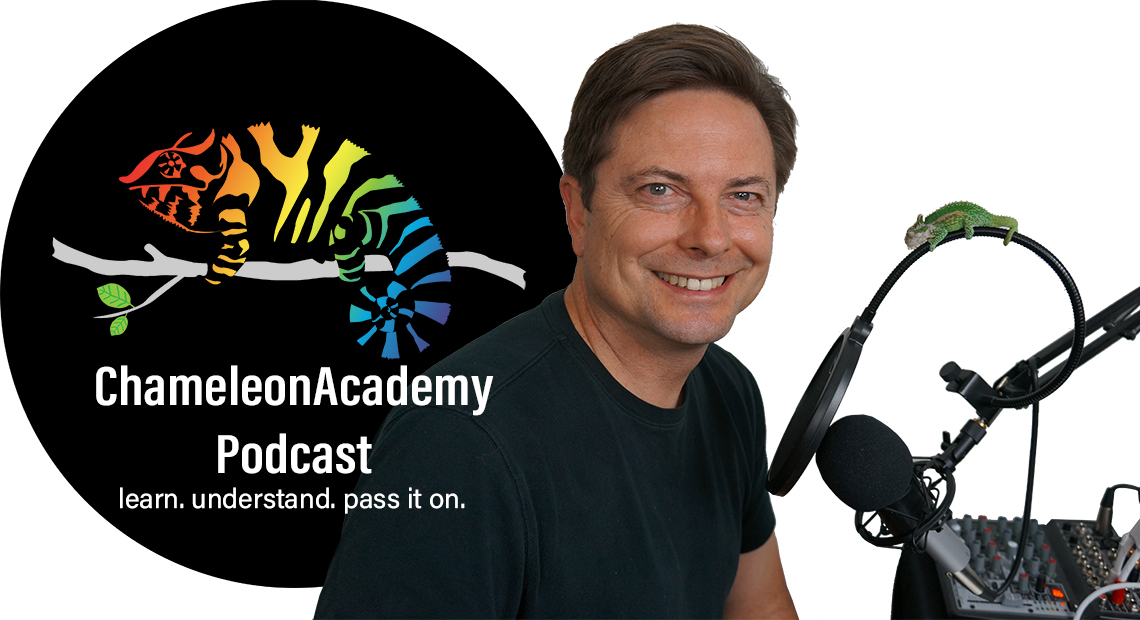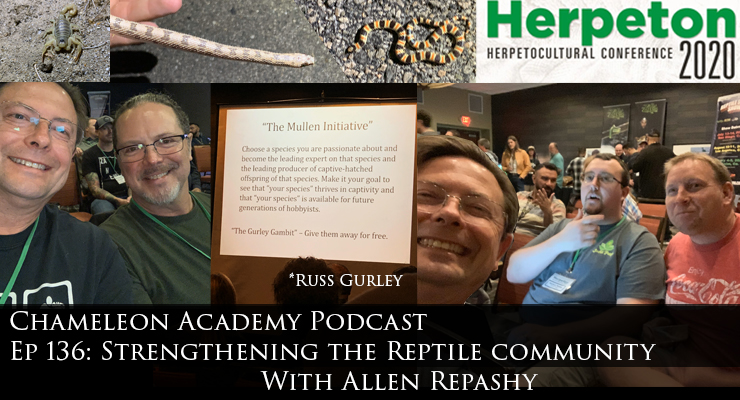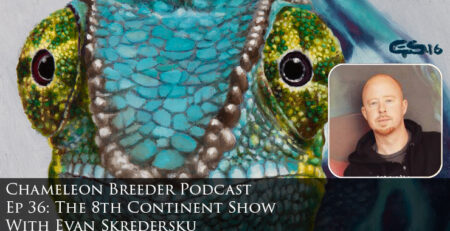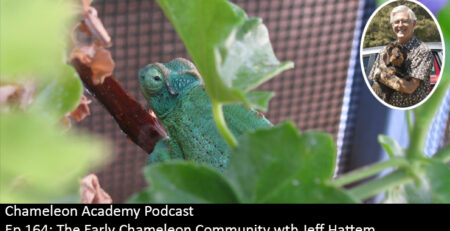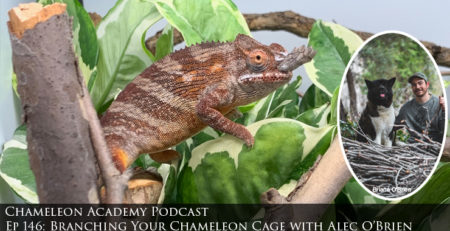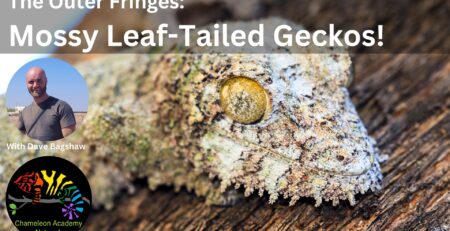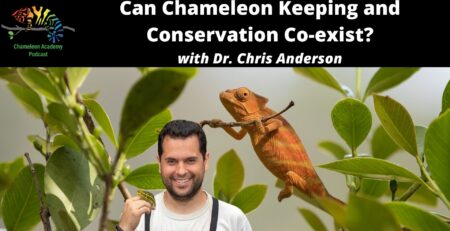Ep 210: Four Pillars of a Strong Reptile Community
Listen Here!
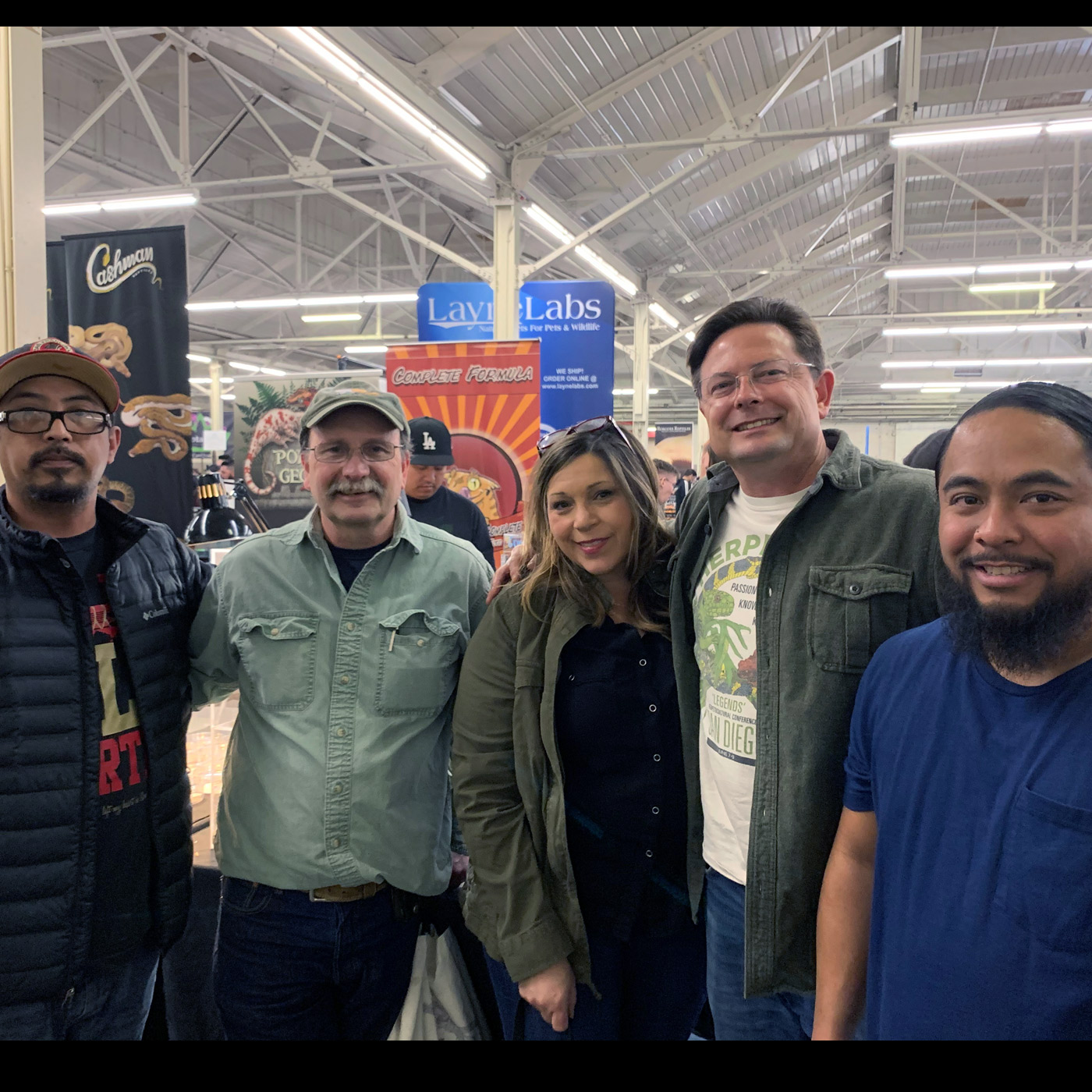

Bill Strand
Four Pillars of a Strong Reptile Community
The reptile community needs to be strong. And to accomplish that we need to be strong in our smaller communities. Whether chameleon, bearded dragon, green tree python, tarantula, or dart frog or all the others we need to maintain a strong specialized community while, at the same time, realizing we are part of a larger national and still larger global community. Today I am going to talk about what it takes for us to make our specialized communities strong.
Transcript (more or less)
Good morning chameleon wranglers! I am sure, by now, you have noticed at the end of almost every podcast episode I close with the words “take care of each other and keep us strong.” Nice words, but what does that mean? What does a strong community look like? And, really, how do you measure strength?
I have been a part of and watched our reptile community for over 40 years. And I have noticed some patterns that I would like to share. For the purposes of this episode, the term “Reptile community” is used loosely to cover the wide variety of ectotherms that are gathered together under the umbrella of the word reptile as far as the pet community is concerned. These include reptiles, amphibians, and invertebrates such as insects, spiders, roaches, bugs, isopods, crustaceans, and anything else that is cold blooded and not fish. And, carnivorous plants, you are big enough to do your own thing, but you are welcome to play in our yard any day. Those other things are not reptiles, but until you guys get big enough to have your own shows you are adopted by the reptile community and you can be part of us as long as you would like. Just know that, for this episode, if I say “Reptile community” I mean all the cold blooded odds and ends that make this world so incredible.
A community is only as healthy as its members allow it to be. If the recognized leaders maintain a strong example of how we should conduct ourselves the community will follow. You can have healthy community even with all the requisite human ego flare ups, personality conflicts, and disagreements if a core foundation of four pillars is maintained. The four pillars are
- Accurate Science Based Husbandry
- Experienced Members
- Community Size
- Commerce
This is the Chameleon Academy Podcast and I specialize in chameleons. But this episode is 100% applicable to every other reptile, amphibian, or invert community from the huge bearded dragon and ball python communities to the budding draco and jumping spider groups. My home specialized community, chameleons, is somewhere in the middle. Everything I talk about for our specialized groups applies to the national and global community as well. And even if I give examples from the chameleon community, I suspect you will have direct parallels in whichever community you are from. Humans tend to be consistent in their habits.
First Pillar: Accurate Science Based Husbandry
The first is Accurate Science based husbandry. This is important because making what we are doing about the quality of life of the animal justifies us doing this at all. Our general standard for care today is much higher than it was 20 years ago. And it is lower than it will be ten years from now. A scientific approach implies that what we accept as proper husbandry is as accurate of a representation of what they need from their environment as possible. As we are still learning what that is, science based husbandry implies that we are constantly studying their activity in the wild, challenging everything we think we know with the new information we get, and testing any ideas in a reproduceable manner. This can be shown in the shift in keeping animals from viewing them as automatons where we give them the right carbon based input and they produce a lifespan to today where we are exploring their emotional health and recognize their importance as life on Earth.
A common vision of providing the most naturalistic captive environment possible will unite the community regardless of country or culture. By using nature as our highest authority we can bypass popularity politics. You know how humans like to form clans behind the loudest or charismatic personality? And when you join certain communities you are now one of them and you have other tribes you are against? I don’t know how to change that part of human nature! But I do know if those leaders have a common goal of the best husbandry that we can still have all those tribes and maybe get our deep need for conflict out by arguing how to pronounce the Latin names instead of the core basics of husbandry.
We can achieve this Accurate Science Based husbandry by applying critical thinking to the husbandry we embrace and the people we listen to. Challenging a new thought can simultaneously be critical and respectful. Leaders in the community should expect to be challenged when providing a new idea. And, on our part, the challenges we present to them should be meant to extract the truth in the statement and remove the chaff. This is not a pass/fail, but a sharpening exercise.
When I say science based I do mean what we work with comes from a study of the reptile’s natural habitat, but I also mean the application of critical thinking to our discussions as we study, challenge, and test ideas. It means we consider all ranges of hypothesizes and judge them based on their merit. I want to specifically bring that up because one way to link our diverse views, cultures, and perspectives is in a common way in which we will test and come to husbandry conclusions.
The scientific method is one that works and we can all agree on. It is a strategy that people of any country can use and understand.
The advantage of the scientific method is that no one has to believe anyone else. If I believe something I create a test and share the results. I also share the test approach so anyone can critique or replicate the test. And that is how we create a core of solid common information for our community. The more in sync we are in solid husbandry concepts, the stronger we are as a community. The responsibility of this one is on people like me and anyone else who is presenting information. And that is the main reason why everything I present has an explanation that you can review enough that you understand it and can test it (if appropriate) and make it your own.
And finally, one aspect of the scientific mind is that it is always pushing forward. This aspect of continually growing in knowledge and application gives our community an energy. For example, we are currently revisiting the husbandry of the Veiled Chameleon. Everyone thought it was easy, but we now know they are just extra hardy and can put up with varying levels of poor husbandry. We are learning more about UVB. About hydration. About nutrition. This increases our success with chameleons which makes it a more enjoyable passion. And, thus, one that people will stick with longer. We will get to deep experience and then community size next! All these pillars are intertwined.
Accepting a scientific approach that is defined by critical thinking is more than just a good idea, it is the one approach to information that will allow us to move forward in sync.
What can you do to make the community stronger? Simple, learn all you can from where ever you land in our community. If you are part of a group then you will be in a sort of echo chamber where the group leaders have directly or indirectly filtered out the information coming to you and you will be hearing the same thing over and over. When you step outside that group you may find the world has wildly different views. Quietly learn the different culture with an open mind. And, yes, this is exactly the same mindset used when you go to another country. Quietly learn their ways before loudly insisting yours is better. The difference between what we are doing and culture is that husbandry that has the purpose of taking care of a chameleon will have, most of the time, a measurable result. So you can respectfully ask questions. You’ll get good answers – or not. Make sure you dig down to the origin of the information to make sure you are getting the best representation of that approach, but the information will be there for you to make a decision as to what aligns with your desired approach.
Second Pillar: Experienced Members
The second pillar of a strong community is a deep base of experienced members. When we start off with anything we tend to simple concepts and be black and white about things because we really don’t understand the subject deeply. It is the experienced people that understand the nuances and are able to help our perspective so we understand the reasons and can make our own judgements. Experienced members anchor the community and take us forward in rational steps. They temper flashy trends and can see through simple hype.
I do want to mention that all experience is not the same. For example: some keepers have been doing the same thing for ten years while another may have been experimenting with different techniques for ten years. Both have value as long as they speak to what they know and do not over extend. Being an expert in one aspect does not make you an expert in all facets of husbandry. Knowing the difference is critical for your experience to be relevant. And to our poor newcomers who are just trying to piece together this husbandry puzzle which has blow up in proportion compared to what they were told at the pet store, there are many levels of experts and I am sorry that the loudest ones aren’t always the truly experienced ones. It is too easy to get your first chameleon, be enthusiastic enough to memorize and repeat all the talking point until you are the go to person for information. You may be surprised that you can get a social media expert badge in about three to six months. I know you can’t research every name that pops up on your screen giving you advice with 100% confidence. The only way to sort it all out is with time. Just give yourself that time to learn the lay of the land before you pledge allegiance to one thought process or another.
So shouldn’t our pool of experienced people simply grow as the community gets older? Unfortunately, it doesn’t work that way. There is significant attrition just because of…well, life.
Add to this that being active generally brings conflict. There is always someone who wants to challenge the big gun or be the only voice. So if you are the experienced person in the room you are the target. This is, again, just how humans work. And this is tiring. So they fade away and their experience is lost. Add to this the ability to memorize all the talking points and then have a three month old member of the community be listened to as a reliable source and there isn’t much incentive for the experienced person to duke it out.
Podcasting is one way to leapfrog this. On this podcast, I have specifically sought out experts around the world to come on. By listening to their interview you can extract the benefit they offer. Their experience can be recorded and referenced by anyone who wants to graduate from memorized talking points.
And that is why I work so hard on how I explain things. When people make their way to the digital doors of the Chameleon Academy I don’t want them to memorize the care summaries. I want them to understand why it is all being said. And herein lies an aspect of my growth as a chameleon community educator. How well I communicate is just as important as the information I am communicating. It is a challenge to condense a multi-facetted natural phenomena of which we have 25% understand of into a one sentence package with an infographic picture.
Now, a note for the experienced community. I get that you don’t have the time to jump into the chaos that is social media.
The absolute best way to communicate your experience is by example. Show pictures of your set-ups and your animals thriving. Show breeding success and share what you are doing regardless of what the admins or loudest voices are saying and don’t worry about the incorrect sound bites bouncing around. The proof is in the life quality of your reptiles. You may not change the people who are trying to be in charge, but those who see what you are doing will approach you and ask you questions. And that is the most effective use of your limited time. It means only be talking to the people who want to listen.
Third Pillar: Community Size
The third pillar of a strong community is the sheer number of members. The math is simple. The more people you have, the higher your purchasing power is and the higher your political power is. The more money the community spends the more services will be built up around that spending. The larger the reptile community the more Exotic veterinarians will be added to vet offices. You know how hard it is to find a reptile vet, much less a chameleon experienced vet? The bigger the reptile community gets the easier that will be. The bigger the community the more business can be supported beyond just critical medical services of an exotic vet. We can now support tour groups to Madagascar. Birders have been doing this for decades. And we can get businesses catered directly for us. Case in point, the chameleon community was big enough that the Dragon Strand Chameleon Caging Company was able to develop. Because of that, an entire new category of hybrid mid and high end chameleon cages was created. Before that it was cheap, screen cages only. So our size benefitted the community by creating product availability that did not exist before. Because of that, the community now has Dragon Ledges which is a patented Dragon Strand product that allows you to mount branches and plants to the sides of screen cages. We are big enough to support innovation that serves us specifically. Even more importantly, we are big enough to support innovation in features rather than in just cost savings. What that means is that a company can dump R&D money into a product to make it perform better and/or to make it cheaper. Mass market cage companies will almost always dump R&D money into making something cheaper. They are catering to the general populace who is not experienced enough to know what quality to look for. So their innovation is to make the product as cheap as possible. Companies from within the community are much more likely to invest money into making a better product. I know that is what I do. The size of our community directly affects the businesses and support that are tailored for our needs.
And politics, the reptile world is big enough to have USARK which is a political office that protects our rights to keep reptiles. And they have no down time. Take a look at their website and you can see what is going on all the time. There is a constant onslaught of legislation designed to criminalize reptile keeping. It is community size that generates enough money to keep USARK going and is able to create enough noise that politicians listen. Size is what allows us to fight back in what is literally a life and death fight for our community.
So there is huge benefit to us encouraging reptile ownership. Now, I understand that reptile or jumping spider or hissing cockroach keeping is not for everyone and I am not saying we should be out there recruiting. I am saying that when people show up on our social media doorstep that we treat them with as much respect as we can and welcome them into the community. We will always have those community members that need to put down the freshman class to feel like they know something. It is up to us seniors to temper that and be an example as to how newcomers should be treated. Here is where perspective comes into play. Social media has allowed us to sequester ourselves into corners where it seems like our little community is the entire world. And we play out all of our human drama within that confined space. All of the ego fluffing, jealousy, politics, good will, helpfulness, compassion, everything that makes up us as human beings is played out on this miniature stage as if the world around us did not exist. We fight each other because, well, humans fight. If we don’t have a common enemy to join forces against we find an enemy within our community because humans seem to need to always being fighting something. It is those of us who manage groups that have to have the perspective that there is a larger world around us that would like us to disappear. They are doing everything possible to choke us out while we fling mud at each other. It is up to us in the leadership roles to look outside our communities and keep the perspective that the more we work together and the larger our community is the stronger we will be to justify services, specialty products, and political protection.
Of course, how we grow is just as important as growing. Growing our community is an important part of our survival. But we must grow it the right way, with the welfare of the reptiles, amphibians, an invertebrates as our primary focus. Because that is growing in strength.
Fourth Pillar: Healthy Commerce
Healthy commerce is intimately tied into community size. The bigger the community the more money flows and the more we are catered to. But that is community size. For this last pillar, I want to focus on healthy commerce within our specialty or umbrella reptile community. These are the reptile breeders, the specialty accessory makers, the feeder insect breeders, and yes, the chameleon cage makers. When you spend money within our community it bounces around inside our community. I can tell you that when you buy a Dragon Strand cage, that money then goes to panther chameleon breeders for the subjects of my panther chameleon educational project. It goes to feeder companies supporting our community. It comes right back around and lets me do this podcast and video channel and chameleon academy website. If you purchase what you need from someone in the chameleon community then money stays within our community and strengthens numerous others in our community. Because where do chameleon people spend their money? With other chameleon people and reptile focused companies! Because, yes, that also goes for general reptile companies.
Healthy commerce is also an important component to keeping experienced people in our community. Money is a sensitive subject. But it is highly relevant to the conversation of how we keep experienced people in the community long term. Money is why you have a roof over your head and internet to listen to this podcast. It is why you can create a slice of Madagascar in your living room. And one way to make sure people stay in the chameleon community is to encourage money to be made within the community. If someone loves chameleons enough to put 10, 20, 30+ years into keeping and breeding then how much more do you think they will be dedicated to staying an active part of the community if that passion for chameleons helps to put that roof over their heads?
Here is where we shoot ourselves in the foot. We self-righteously bristle whenever someone is making money off chameleons. Have you ever heard the phrase, “well, they are only in it for the money” whenever someone doesn’t get their way? Have a seat for what I am about to say next. Making money, meaning profit, is what makes a viable business. If you are giving away panther chameleons or charging less than it takes to run a breeding operation you are running a charity and your payment is in the community patting you on the back and saying you are such a great person for you giving up of your money so they can keep theirs. Because, in reality, people say “this breeder is only in it because of the money” usually because they themselves what to hold on to money because, you guessed it, they only care about money. It is amazing how many self-righteous statements are simply mirrors. I am harping on this because successful business is a community builder. It is what encourages people to stay in a community long term. How many of those people you know of that are still active in the community after ten years are breeders or have some other thing they sell? Quit a few. Obviously, not all, but I suspect you will find that a large number of 10+ year people who are active on a day to day basis adding to the community have a business tie. Can you guess why this is? It is because the reptile community, like any other animal, or craft, or other community that is composed of human beings, is a rough place to be. Fighting, drama, and back stabbing, oh my. People who stick around need a reason to stick around.
And I am not saying everyone gets out of chameleons if they don’t make money! What I am saying is that they fade away from active community involvement and stick to their own quiet, non-drama friends. So why does it matter? Why am I taking you down this winding path? It is because we need to have a healthy concept of money as to how it relates to building a healthy community. People who make money from a community stay in the community because they can justify the time they spend to learn and gain experience. So, maybe an example is in order. And we can make this a personal example. I will talk about me. Why do I do what I do?
I am involved in chameleon education because I love it. I have a passion researching all aspects of chameleon husbandry. And I have a special passion in taking those concepts and finding ways to present them so they are understandable. I love teaching. But there is a financial cost to writing and producing these podcasts, videos, and maintaining care summaries, hand outs, and a website with 259 pages and posts filled with the latest in chameleon information. And, yes, I have to update it on a regular basis to keep it current. That is an enormous amount of work. There is a direct financial outlay and there is a very real opportunity cost. That means there is a cost I pay by choosing to do this with my time instead of something that makes more money. And we make these decisions all the time. A breeder that houses veiled chameleons instead of higher priced panther chameleons is paying an opportunity cost of several hundred dollars per baby. A person spending 8 hours a day breeding chameleons and finds out they are making less than minimum wage per hour is paying an opportunity cost by choosing what they enjoy instead of what makes more money. A person working with chameleons when they have the option to work at a more lucrative job is paying an opportunity cost.
So fine, we got the basic business concept. But why does everything have to be a business and make money? Can’t I do something for fun? Of course. There is no reason for turning everything into a business. In fact, that is the fastest way for it to no longer be enjoyable! What I am getting at, though, is that the majority of people who stick around do have at least some profit from the community. And that, in a way is both an incentive and a trap. If you have a community business then you leaving the community is leaving your business. And if that business truly contributes to the bottom line then you are getting enough benefit to weather a substantial level of social media chaos and craziness. People that have nothing going to the bottom line from the chameleon community tend to take long breaks on a regular occasion the more experienced they become. The point of all of this is not to say you need to develop a chameleon related business, but I am encouraging you to actively support business by chameleon community members. Supporting businesses founded and run by active members of the reptile community is the single best way to make sure we have the right products and technology moves ahead
And, for goodness sake, don’t sabotage community member businesses because of petty social media fights.
This doesn’t mean that you have to pay more because someone in the community sells a more expensive product. Find the right product and right price. But one thing you can do to strengthen our community is to 1) actively support community businesses or, 2) if you just can’t stand the person, simply do not actively sabotage community members. I get it. Not everyone gets along. I have my handful of people I want to have nothing to do with. I don’t think there is anyone that doesn’t have a list of people they just avoid. But if they have a business within the reptile community I will support them, even if that support means I will keep silent when I could hurt their business with a snide comment on social media. A small side business is a very real way that experienced community members have a justification for being actively involved in community building. And that is a good and positive dynamic for us all.
And consider our responsibility surrounding where we spend our money. We literally create the community we pay for. Our disgust for inhumane treatment of herps and invertebrates is mere background noise until we speak with our wallet. We must encourage and enthusiastically support companies that are vocal about quality reptile care. We must acknowledge that our community’s past, and, unfortunately, present has reptiles, amphibians, and invertebrates treated as throw away toys. It is our responsibility and mission to educate the buying community that this is not acceptable.
It costs money to properly take care of and breed reptiles. Do you want a community that has four to six month old captive born Jackson’s Chameleons available for $150 – $200 where they are well started and healthy? Or are the 3 week old babies born in the wild caught holding cell for $50 good enough for you? Do you know how much time me and my team spend on the Jackson’s Chameleon Community Facebook group with people who got a cheap Jackson’s chameleon baby and are asking how to save its life? Most of the time, you can’t. What a tragedy for both the chameleon and the keeper. Now imagine a community where businesses like that couldn’t sell enough chameleons to continue stocking them because too many customers demanded to see the breeding set up and get assurances that the mother had been properly cared for. We can create a community where the responsible breeder has a wait list while the meat market can’t sell. Is that optimistic? Yes, it is. Cheap things will always sell. And so there will always be a market for cheap reptiles. But we can shift things towards responsible breeding if we spend our money in the right places. Patronize breeders that demonstrate quality care for their animals. Be willing to pay for top care given all the way back to the mother when she was a baby. In fact, refuse anything less than a breeder that demonstrates top husbandry practices. It is critical that we see our money as a tool for creating the community we desire. Reptile keeping is a luxury and a privilege that is threatened by both politics and environmental crisis’. Financially supporting community member businesses, political efforts, and environmental healing is a part of taking care of our community in a holistic way.
Conclusion.
This podcast episode is for those of us in the reptile, amphibian, and invertebrate communities long term that consider this our home. We are the ones that are setting the tone for the entire community. If we value what we have we need to keep in mind the perspective that how we structure our interactions affects the larger picture. Are we fighting amongst ourselves or organizing donations to USARK or Eden Reforestation to restore the natural environments? Are we back stabbing and sabotaging or actively building up community members that are helping us have commerce that is specific to our needs? If you are a leader or social media influencer, how you conduct yourself will set the tone. People are going to look up to you and follow your lead. You can be a positive influence by making sure what you present is in keeping with pushing your community forward in husbandry. Get as close as you reasonably can to replicating the important parts of their natural habitat and share it as an example. Highlight experienced members that you respect and learn alongside with your audience or group. Show what it looks like to be patient with a newcomer. And verbally support the businesses within the reptile community that you frequent. You can touch on these four pillars in your day to day interactions whether you are a podcast, video channel, Facebook group admin, Instagram account, or any other social media outlet member. We all have a part we can play to strengthen our local community and in turn contribute to the solid foundation of the entire national and global community.
So what now? Well, what is your part? You will have something that you are able to offer. Are you able to offer financial support? From USARK to Eden Reforestation to your local reptile rescue to the patreon account of a content creator that has made a difference in your life the opportunities are plentiful. Are you patient with gently explaining the same thing over and over again? I cannot tell you how much we need you on social media. Can you create videos? Would you like to host a podcast? Do you like to write? Do you understand Tik Tok? The more responsible, naturalistic minded content creators we have out there demonstrating proper husbandry the more reptiles will have a quality life. You don’t have to argue to be effective. Simply show what you do and be an example. Do you have an idea for a product that would make caring for your favorite species better or easier? Consider a side business catering to that small niche of the market. I don’t know what species you are thinking about, but there may be a bigger audience out there than you know. Try it. Do you need someone to bounce ideas off of? If you are truly serious about a product idea, podcast, video channel, or other outreach then email me at bill@chameleonacademy.com. I am not going to steal your idea. I will give you perspective from someone who has been there. I won’t do it for you, but I may be able to help bridge some gaps or brainstorm around stubborn roadblocks. It took me two years to actually start this podcast. I am presently struggling through a product design challenge. I have been there. I know the feelings of doubt and all the voices, real and imagined, that are pulling you down. I believe that the more people who get actively involved in products or content creation the stronger we are as a community. So yes, I will help you. Although don’t talk to me if you want to start a chameleon caging company. That would be a conflict of interest. But otherwise, I know how lonely it is when you don’t have anyone around you that sees your vision. And, generally, people are either good at product or they are good at marketing. It is rare to find both in one person. Believe me. In my professional life I run product marketing departments for consumer electronics companies. Good product marketing professionals are exceptionally difficult to find. So how hard is it to find someone who understands product, understands marketing, and understands the reptile market? I would be happy to provide basic advice, realistic encouragement, and cautions that could help you get passed what is holding you back and avoid pitfalls as you move forward. If you are ready to put it into action and need a little push, a little insight, a little perspective…the email is bill@chameleonacademy.com
We deserve the community we create. Whether through our money, time, or energy everything we do adds to or takes away from it. Realize that your contribution to the community, no matter what it is, is greater than the effort in itself. When others see what you are doing it encourages like behavior and your efforts are multiplied. Thank you for joining me here this week for this very important topic. Let’s make a better community.


